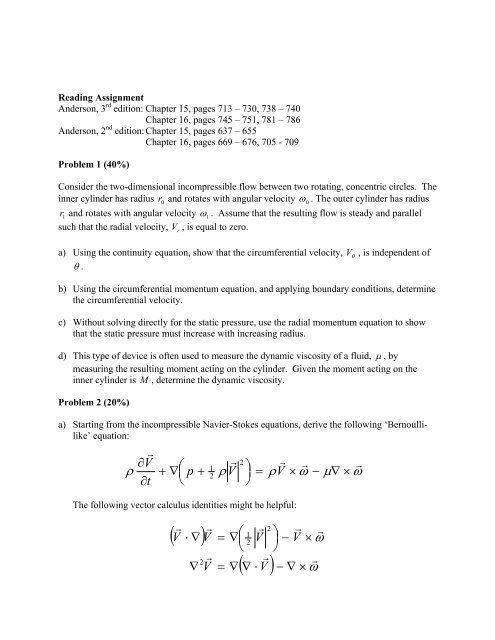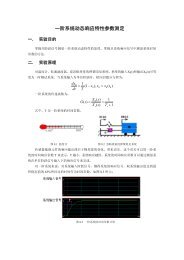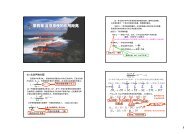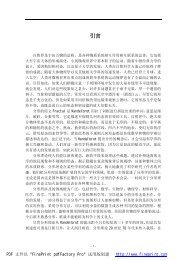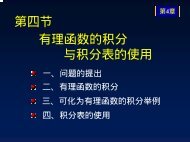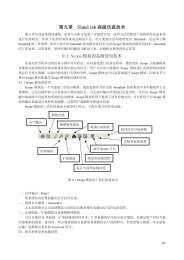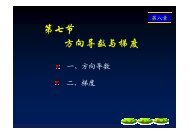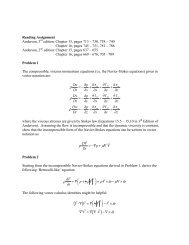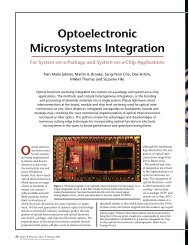Assume that the local skin friction coefficient in turbulent flow is ...
Assume that the local skin friction coefficient in turbulent flow is ...
Assume that the local skin friction coefficient in turbulent flow is ...
Create successful ePaper yourself
Turn your PDF publications into a flip-book with our unique Google optimized e-Paper software.
Read<strong>in</strong>g Assignment<br />
Anderson, 3 rd edition: Chapter 15, pages 713 – 730, 738 – 740<br />
Chapter 16, pages 745 – 751, 781 – 786<br />
Anderson, 2 nd edition: Chapter 15, pages 637 – 655<br />
Chapter 16, pages 669 – 676, 705 - 709<br />
Problem 1 (40%)<br />
Consider <strong>the</strong> two-dimensional <strong>in</strong>compressible <strong>flow</strong> between two rotat<strong>in</strong>g, concentric circles. The<br />
<strong>in</strong>ner cyl<strong>in</strong>der has radius and rotates with angular velocity ω . The outer cyl<strong>in</strong>der has radius<br />
r0<br />
0<br />
r1<br />
and rotates with angular velocity ω<br />
1<br />
. <strong>Assume</strong> <strong>that</strong> <strong>the</strong> result<strong>in</strong>g <strong>flow</strong> <strong>is</strong> steady and parallel<br />
such <strong>that</strong> <strong>the</strong> radial velocity, V<br />
r<br />
, <strong>is</strong> equal to zero.<br />
a) Us<strong>in</strong>g <strong>the</strong> cont<strong>in</strong>uity equation, show <strong>that</strong> <strong>the</strong> circumferential velocity, V , <strong>is</strong> <strong>in</strong>dependent of<br />
θ<br />
θ .<br />
b) Us<strong>in</strong>g <strong>the</strong> circumferential momentum equation, and apply<strong>in</strong>g boundary conditions, determ<strong>in</strong>e<br />
<strong>the</strong> circumferential velocity.<br />
c) Without solv<strong>in</strong>g directly for <strong>the</strong> static pressure, use <strong>the</strong> radial momentum equation to show<br />
<strong>that</strong> <strong>the</strong> static pressure must <strong>in</strong>crease with <strong>in</strong>creas<strong>in</strong>g radius.<br />
d) Th<strong>is</strong> type of device <strong>is</strong> often used to measure <strong>the</strong> dynamic v<strong>is</strong>cosity of a fluid, µ , by<br />
measur<strong>in</strong>g <strong>the</strong> result<strong>in</strong>g moment act<strong>in</strong>g on <strong>the</strong> cyl<strong>in</strong>der. Given <strong>the</strong> moment act<strong>in</strong>g on <strong>the</strong><br />
<strong>in</strong>ner cyl<strong>in</strong>der <strong>is</strong> M , determ<strong>in</strong>e <strong>the</strong> dynamic v<strong>is</strong>cosity.<br />
Problem 2 (20%)<br />
a) Start<strong>in</strong>g from <strong>the</strong> <strong>in</strong>compressible Navier-Stokes equations, derive <strong>the</strong> follow<strong>in</strong>g ‘Bernoullilike’<br />
equation:<br />
r<br />
∂<br />
ρ<br />
∂t<br />
+ ∇⎜<br />
⎛ p +<br />
⎝<br />
r<br />
ρ V<br />
V 1<br />
2<br />
2<br />
The follow<strong>in</strong>g vector calculus identities might be helpful:<br />
r<br />
r<br />
V<br />
r<br />
2<br />
∇ V<br />
( V ⋅ ∇)<br />
⎟<br />
⎞<br />
⎠<br />
r<br />
∇⎜<br />
⎛ 2<br />
1<br />
=<br />
2<br />
V<br />
⎝<br />
r<br />
= ∇ ∇ ⋅<br />
r r r<br />
= ρV<br />
× ω − µ ∇ × ω<br />
⎟<br />
⎞<br />
⎠<br />
r r<br />
− V × ω<br />
r<br />
( V ) − ∇ × ω
) Show <strong>that</strong> <strong>the</strong> total pressure,<br />
<strong>flow</strong>.<br />
r<br />
p + , <strong>is</strong> constant along a streaml<strong>in</strong>e <strong>in</strong> a steady, <strong>in</strong>v<strong>is</strong>cid<br />
2<br />
1<br />
2<br />
ρ V<br />
c) Show <strong>that</strong> <strong>the</strong> total pressure <strong>is</strong> constant everywhere <strong>in</strong> a steady, <strong>in</strong>v<strong>is</strong>cid, and irrotational<br />
<strong>flow</strong>.<br />
Problem 3 (40%)<br />
p a<br />
V w<br />
p b<br />
L<br />
Consider <strong>the</strong> 2-D <strong>flow</strong> between two porous walls of length L at y = ± h . <strong>Assume</strong> <strong>that</strong> <strong>the</strong> length<br />
of <strong>the</strong> walls <strong>is</strong> much larger than <strong>the</strong> half-height h so <strong>that</strong> <strong>the</strong> <strong>flow</strong> may be assumed to be constant<br />
<strong>in</strong> <strong>the</strong> x-direction. The upper wall produces a suction such <strong>that</strong> <strong>the</strong> velocity normal to <strong>the</strong> wall <strong>is</strong><br />
V w<br />
and <strong>is</strong> positive. Solve <strong>the</strong> <strong>in</strong>compressible Navier-Stokes equations to f<strong>in</strong>d <strong>the</strong> velocity and<br />
pressure everywhere <strong>in</strong> duct for <strong>the</strong> case <strong>in</strong> which <strong>the</strong> pressure <strong>in</strong>let and exit of <strong>the</strong> pipe are<br />
p and p , respectively. Specifically, you should f<strong>in</strong>d <strong>the</strong> follow<strong>in</strong>g solution for <strong>the</strong> x-velocity:<br />
a<br />
b<br />
u<br />
u<br />
0<br />
=<br />
2<br />
Re<br />
⎛<br />
⎜<br />
⎝<br />
y<br />
h<br />
− 1<br />
+<br />
Re Re<br />
e − e<br />
s<strong>in</strong>h Re<br />
y<br />
h<br />
⎞<br />
⎟<br />
⎠<br />
where u0<br />
<strong>is</strong> a constant <strong>that</strong> you must determ<strong>in</strong>e as part of <strong>the</strong> solution and <strong>the</strong> Reynolds number<br />
<strong>in</strong> th<strong>is</strong> problem <strong>is</strong> def<strong>in</strong>ed as<br />
V w<br />
h Re =<br />
.<br />
ν<br />
Plot u u0<br />
for Re = 1, 10, and 100. Based on <strong>the</strong>se plots, describe <strong>the</strong> basic behavior of <strong>the</strong><br />
velocity as a function of <strong>the</strong> Reynolds number.


